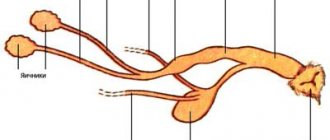Losing a dog is a pressing problem for many owners. Widely used identification methods that allow a pet to return to its owner - address tags, branding - most often turn out to be ineffective. Address cards and collars are lost in the process of wandering, the brand is not readable. The modern world offers a new way of applying information to a dog - introducing an electronic chip under the skin. From the article you will learn: is the chipping procedure mandatory, how and where it is performed, what advantages and disadvantages it has.
What is chipping
Microchipping of dogs is a manipulation involving the introduction of an electronic device under the dog’s skin—a transponder that is microscopic in size and does not cause any inconvenience to the animal. It contains unique information and code. The small device consists of parts:
- receiving block;
- transmitter;
- antenna;
- information block;
- the capsule itself, which has a bioglass shell.
The chip is programmed with information about the dog, which must be entered into a single database compatible with similar international resources. The code consists of 15 characters:
- country code (Russia – 643);
- manufacturer code (next 4 digits);
- a unique dog code that cannot be faked or changed in the future. This code contains information: name, breed, age, health status, existing pathologies, complete data of the owner.
The question arises: is microchipping pets the responsibility of owners in our country? Conversations and discussions have been going on since 2011. It was planned that the law mandating such a procedure would come into force in 2022.
In December 2022, the Federal Law “On the Responsible Treatment of Animals” was adopted, which contains information on the need to label animals in certain circumstances. But there is no question of mandatory microchipping. At the same time, the Order of the Ministry of Agriculture of Russia includes dogs in the list of animals subject to mandatory identification by any known method.
Thus, the legislation does not yet directly indicate the mandatory microchipping of pets, and no administrative liability has been established for the lack of a procedure. But some regions of the Russian Federation are adopting local legislative initiatives that provide for mandatory registration of animals - microchipping.
Microchipping an animal becomes a requirement if you are planning to travel abroad.
Since there is no law on mandatory microchipping yet, such identification is voluntary. When adopting such an act, the owner will be able to carry out the procedure “retroactively” in order to comply with legal requirements.
Photo: media.defense.gov
Common Misconceptions
Despite all the obvious advantages, there are still some deviations in the microchipping procedure that veterinarians prefer not to talk about.
And we will list them:
- Microchipping dogs is completely painless and does not cause any adverse reactions in the body. In fact, chipping does not really cause pain, but only if performed by a qualified specialist. Often, an inexperienced doctor simply pierces the surface layer of skin with a needle, but the chip gets tangled in the dog’s fur and after some time simply falls out and is lost. This happens especially often with animals with long and thick hair.
- A small percentage of four-legged animals have an individual intolerance to the components from which the biocapsule is made. In case of intolerance or incorrect insertion of the chip, the injection site may become inflamed and fester.
- Once implanted, the chip is overgrown with connective tissue and fixed in one place. In fact, the chip implanted in the withers sometimes “migrates.” Deviations may be 1-2 cm from the area where the chip is implanted. But I have not heard of cases of the negative impact of such movement on the health of a four-legged animal.
- The implanted device does not deteriorate and is easily read by a special scanner. It happens that the entire chipping procedure goes perfectly, but after a couple of years the scanner simply stops reading information from the microchip. There could be a lot of reasons for this. From simple malfunctions in the operation of the device, to demagnetization from exposure to electromagnetic waves. Therefore, if you are going on a trip abroad with your pet, you should be safe in advance and check the serviceability of the microchip so that when passing veterinary control you will not end up in an unpleasant situation.
- If you purchase an adult animal that has already undergone the microchipping procedure, then you will have to come to terms with the fact that information about its previous owner is already entered in the database. And if the four-legged animal has already changed more than one family, then if it goes missing, finding the current owner will be very problematic. The only way out is to remove the old chip and implant a new one.
- If desired, it is very easy to get rid of the chip. You just need to feel the chip through the skin, make an incision and pull out the capsule. This is easiest for dogs with thin skin and little hair.
Why is microchipping necessary?
As soon as the first such electronic devices appeared, owners of rare and expensive representatives of animal breeds paid attention to them. By inserting a microchip under the pet's skin, they hoped to protect it from theft. Please note that such a device cannot be tracked. The standard transponder does not have a GPS module; its range of action is several centimeters. You will have to bring the scanner close to the dog to read the information.
Why is it necessary to install a chip? It allows:
- obtain complete information about the owner;
- be confident in purchasing exactly the puppy that was chosen;
- resolve a dispute about the ownership of a dog;
- prevent the substitution of animals at exhibitions and competitions;
- freely visit other countries with your pet;
- participate in exhibitions (since 2010 – a mandatory requirement);
- quickly obtain information about health, existing pathologies and allergies when changing doctors, moving, or traveling.
Photo: media.defense.gov
General information
Humanity has long been looking for ways that would allow other people to immediately find out whose pet is in front of them.
A variety of methods were used:
- Branding, including using a hot iron
- Tattoos
- Scarring
- Banding
- Coloring
- Ear piercings
But none of these methods became the “gold standard”, since each had significant drawbacks, and besides, they were often cruel.
With the help of modern technologies, a method has been invented that is the least painful, very fast, relatively cheap and at the same time gives the optimal result today. Chipping is the implantation of a microchip under the skin of an animal, which contains information not only about the owner, but also about the animal itself.
Using a chip and a special scanner you can find out:
- Breed of dog
- Her health status, including vaccinations
- Owner contact details
Important! The importation of dogs without a chip into EU countries is prohibited.
When can an animal be microchipped?
The chip can be inserted from a very early age: 5-6 weeks. The main condition is that the dog must be healthy. Implantation of the device does not require any special preparation from the owner and pet. It is carried out in any veterinary clinic trusted by the owner, or at home.
When traveling outside the country, pay attention to the requirements for the introduction of chips at the place of arrival. In some countries, vaccinations given before the implantation procedure may be considered invalid.
By appearance
How to check the authenticity of a dog's pedigree? If the owner holds a document of a certain type in his hands, then he can be sure that the pedigree is real. It's all about the hologram and watermarks, which are noticeable upon closer inspection of the pedigree, as well as in the profile image of the greyhound.
Let's talk a little about deciphering the RKF pedigree. In the center are the dog's details: name, breed, date of birth, brand, color, breeder and owner. The document must contain information about the pedigree and its serial number in the RKF.
Under the numbers “1” and “2” are the dog’s father and mother, followed by grandparents, great-grandparents.
How does chipping work?
The insertion of the chip itself is a simple manipulation, reminiscent of vaccination. Everything takes a few minutes. It all depends on the mood and psychological state of the animal.
- Before the procedure begins, the veterinarian must scan the chip to ensure it is working.
- The chip itself is inserted with a disposable sterile syringe, subcutaneously into the withers area or under the left shoulder blade (long-haired individuals), into the area of the inner thigh (short-haired individuals). In addition to the device itself, the syringe contains a liquid that facilitates injection.
- The size of the equipment being introduced is comparable to a grain of rice. The shell is made of bioglass, compatible with living tissues. After a week, such a capsule will be tightly surrounded by tissue and will be motionless and will not bother the dog.
- The entered chip is scanned again. After scanning, the veterinarian enters the information into the national database. The largest at the moment are: https://www.animal-id.ru/ and https://animalface.ru/, Internet resource PETMAXX. These resources are part of international systems and will allow the owner to obtain information outside the country.
- A note about the procedure performed is made in the veterinary passport - a barcode is pasted in.
The introduction of an electronic chip is a once-in-a-lifetime procedure.
Preparation and contraindications
As already noted, no special preparation is required before chipping. In fact, there are no contraindications to the insertion of a chip. Some individuals may experience an allergic reaction to the components of the injection, but very few such cases have been identified. No other complications were identified after the chip implantation procedures. What difficulties may arise:
- During the procedure, as well as during vaccination, individual individuals may whine, twitch, or even bite. This is the result of the dog’s emotional state, and not the pain of the procedure. However, you should only contact experienced veterinarians;
- A lump may appear at the site where the device was inserted, which will resolve the next day. You need to monitor the injection site and if inflammation occurs, contact the clinic immediately.
Advantages and disadvantages
| Advantages | Flaws |
|
|
Action plan for the loss of a microchipped pet
If an animal is missing, you must open the website where it is registered and announce that the pet is wanted. It is important to indicate the microchip number, breed, gender, and special features by which the dog will be immediately recognized during searches. It is advisable to post a photo.
If your dog has a chip, it will be much easier to find him
It is also worth reporting the loss of your pet to the veterinary clinic where the chip was placed. This is necessary so that if the dog is found and brought to the doctor, it can be easily identified. The owner will be informed about the found animal and offered to take it home.
For your information! If the owner suspects that the pet has been stolen, you can contact the Ministry of Internal Affairs. In this case, the police will search for the dog.
How much does it cost to chip dogs?
Currently, the introduction service is performed by almost all veterinary clinics. The price of microchipping dogs is low: from 1000 to 2000 rubles, depending on the location (at home or in a clinic), on the size of the hospital and promotions. Public veterinary hospitals often offer free microchipping promotions.
Offers have appeared on the market with chips that cannot be read by standard scanners and do not have documentation, licenses or technical support.
Chipping with such devices will not bring any benefit; information from them will not be able to get into national and international databases.
Finding a chipped dog
The microchip does not contain a GPS tracker, so a microchipped dog cannot be tracked in real time if it is lost. But the owner has the opportunity to immediately contact one of the Internet resources with a database of microchipped animals. There, an application is drawn up indicating the details of the lost pet. As soon as the chip is read, the owner will know about it immediately.
It will be impossible to take such an animal out of the country; an application from the owner on the website is a statement of theft of property. Thus, it is much easier to find a lost dog using a chip.
What is it for?
It is not very clear why microchipping is done for pets that have a breed mark. In fact, the brand and the chip have the same functions.
Expert opinion
Kuzmenko Olga Olegovna
Information about the expert
Ask a Question
However, the stamp may fade. And unscrupulous people can even kill it in order to hide the animal’s past. In this case, veterinarians do not replace the chip, so data about the real owner, health status and other characteristics of the pet will be impossible to fake.”
Common questions about microchipping
Is the procedure always painless?
Yes, sure. A prerequisite is that it is performed by an experienced doctor. An inexperienced doctor may insert the microchip incorrectly, it will get tangled in the fur and get lost.
Is it possible to wash the dog after the procedure?
It is better to postpone washing for a week while the device becomes fouled with fabric.
Can the device deteriorate over time?
Yes maybe. For various reasons: demagnetization, defects and others. Before traveling abroad, you need to check the functionality in the clinic.
How to make changes about the owner if the dog has changed family?
It is not possible to make changes to the device. Exit: remove the old chip, enter a new one with new information.
Obtaining a pedigree
Before you think about how to check a dog's pedigree, you need to understand how to get it.
The pedigree is obtained through the breeder after the dog reaches 15 months of age. Before this, the main document is the “puppy card” - a kind of pet birth certificate. Once the animal reaches the stated age, the “puppy” changes to pedigree.
Owner reviews
Ivan K.
We are a very active family and travel constantly. We got such an active breed - Jack Russell terrier Archie. We decided right away that the dog would go everywhere with us. I really didn’t want to leave him at home alone. We came to see the doctor about what vaccinations we need to get for a trip to Germany. They explained to us that to cross the border of the European Union countries we would need a chip. It sounded a little scary. But the device turned out to be microscopic. The procedure went quickly and unnoticed. There was no inflammation. We go everywhere. It is very convenient to microchip a dog - in any country the doctor understands the dog’s health status, there is no need to waste time on fussy explanations.
Olga H.
I am a Husky breeder. Microchipping is a mandatory procedure for all puppies in our kennel. Firstly, this is a mandatory condition for participation in exhibitions both in our country and abroad. Secondly, I am not afraid that the dogs may be stolen and tried to be passed off as their own. Such disputes are resolved very quickly by simply bringing the scanner to the dog.
Briefly about the main thing
- Chipping is a modern way of registering and further identifying an animal;
- The law does not contain a requirement for the mandatory introduction of an electronic device under the skin of a dog on the territory of the Russian Federation, only in certain regions;
- Manipulations can be carried out from the age of 5-6 weeks, there are no serious contraindications;
- Having a chip is mandatory for traveling abroad and participating in exhibitions;
- It has many advantages and minor disadvantages.
Have your pets undergone this procedure? Why did you decide to do it? What are the benefits? Did inserting the chip help? Tell us about your experience in the comments, please.
Did you like the article? Share it with your friends on social media. networks. This will help them get useful information and support our project.
Chip device
The operation of this method is based on radio frequency interaction of the implanted chip with a special scanner. The chip itself is a small microcircuit in which all the information is stored, as well as a shell that allows you to easily implant the chip under the pet’s skin.
There are two types of chips:
- 12x2 mm (standard)
- 8x1.4 mm.
The smaller chip is used to identify small animals: small dogs, reptiles, cats and rodents. The standard size is suitable for microchipping medium and large breed dogs, as well as horses, pigs, and large reptiles.











